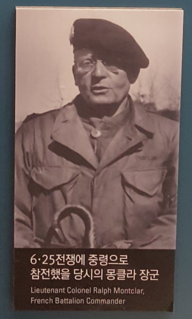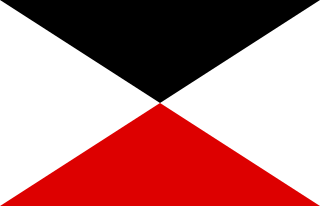
Prince Dimitri Zedginidze-Amilakhvari, more commonly known as Dimitri Amilakhvari was a French military officer and Lieutenant Colonel of the French Foreign Legion, of Georgian origin who played an influential role in the French Resistance against Nazi occupation in World War II, and became an iconic figure of the Free French Forces.

Khenifra is a city in northern central Morocco, surrounded by the Atlas Mountains and located on the Oum Er-Rbia River. National Highway 8 also goes through the town. The population, as of a 2014 census, was 117,510.
Jules Gaucher was a French Army officer noted for his command of Foreign Legion troops in Indochina. Described as a "burly, hard-drinking veteran of years of jungle fighting, with a nose like an axe-blade and a mouth like its cut", Gaucher was a popular commander among the Legion, known as 'the Old Man' to his troops. He was killed at the Battle of Dien Bien Phu in 1954.

Aarne Edward Juutilainen, nicknamed "The Terror of Morocco", was a Finnish army captain who served in the French Foreign Legion in Morocco between 1930 and 1935. After returning to Finland, he served in the Finnish army and became a national hero in the Battle of Kollaa during the Winter War with the Soviet Union. He was wounded three times during World War II.

Raoul Charles Magrin-Vernerey, other known as Ralph Monclar born 7 February 1892, was a French officer and 2nd Inspector of the Foreign Legion who fought in World War I, World War II within the ranks of the Free French Forces and led the French Battalion in the Korean War. He was also one of the first senior officers to respond to the Appeal of 18 June.

The 6th Foreign Infantry Regiment was an infantry regiment of the French Foreign Legion from 1939 to 1941 and again from 1949 to 1955.
Marcel Jean Marie Alessandri was a French army officer who served in the World War I, World War II, and the First Indochina War. During World War II, he was stationed in French Indochina where he ultimately assumed supreme command of the French forces in China, in addition to assuming responsibility for the administration of the French government in China. In the course of his military career he received the Croix de Guerre twelve times in addition to numerous other citations and commendations.
Paul Lacombe de La Tour was a French army officer who served from 1910 to 1940 through both World War I and World War II. He eventually rose to the rank of lieutenant-colonel and led the 97th Reconnaissance Group of the Infantry Division into combat during the Battle of France. La Tour was killed in action while commanding a rear guard action which was covering the withdrawal of the 7th North African Infantry Division across the Oise River.

Jean Marie Joseph Degoutte was a French general active in the colonies and the First World War.
Lieutenant-General Henry Freydenberg was a French army officer. He was born in Paris on 14 December 1876 of German descent family.
General Jean Baptiste Philippe Théveney was a French army officer. His father was a cavalry officer and Théveney was educated at the Ecole Spéciale Militaire de Infanterie before being commissioned as an infantry officer. He served in a number of staff and regimental appointments in France before joining the 1st Foreign Regiment of the French Foreign Legion and seeing active service in Algeria. Théveney followed the regiment to Morocco where it was involved in the Zaian War against the Berbers.
Lieutenant-Colonel René Philippe Laverdure was a French army officer. He enlisted in the army as a private soldier in 1880 and saw active service with the 1st Marine Infantry Regiment and the Regiment de Tirailleurs Annamites in the Tonkin Campaign in modern Vietnam. He was promoted through the army's non-commissioned ranks and became an adjutant in 1884. A display of bravery on the battlefield won him a commission later that year.

General Noël Marie Amédée Garnier-Duplessix or Duplessis was a French army officer. Whilst still a colonel he commanded the 2nd Infantry Division in the Allied victory at the First Battle of the Marne before seeing service in the Zaian War in the French protectorate of Morocco. Garnier-Duplessix returned to France in October 1916 and received command of the 37th Infantry Division for the 15 December offensive of the Battle of Verdun and the Nivelle Offensive of April 1917. He received command of the 9th Army Corps in June 1918 and led that unit to victory in the August Battle of Amiens and the autumn Meuse-Argonne Offensive. After the war he was posted to Cilicia in the Franco-Turkish War of 1918–21 where he argued against early withdrawal of troops following the March 1921 Cilicia Peace Treaty.

Colonel Marie Augstin Gaston Cros was a French army officer and archaeologist. He was born in Alsace and was displaced when that territory was incorporated into the German Empire. He joined the French Army as a lieutenant and saw action in Tonkin before spending several years surveying in Tunisia, receiving the honours of membership of Vietnamese and Tunisian orders and appointment as a chevalier of the Legion of Honour. In 1901 Cros was appointed head of the French archaeological expedition to Girsu, Iraq to continue the work of Ernest de Sarzec. His work over the next five years included the tracing of the 32.5 feet (9.9 m) thick city wall and for his work there received a letter of commendation from Gaston Doumergue, the Minister of Fine Arts, and the award of the Golden Palms of the Ordre des Palmes Académiques. Promoted to lieutenant-colonel, Cros served in the French protectorate of Morocco from 1913, seeing action in the Zaian War.
Moha ou Said l'Irraoui was a Moroccan tribal leader who opposed French rule of the protectorate of Morocco. He formerly served as a caïd of the Moroccan sultans and fought for Sultan Abdelaziz against rebels in 1902. After Treaty of Fez and the start of the French protectorate he opposed the French through military action. He participated in several battles with French forces in the Zaian War but was eventually forced into the High Atlas mountains where he died in action in 1924. His followers continued to resist the French over the next ten years.
General Antoine Jules Joseph Huré was a French army officer and engineer noted for his service in Morocco. Huré joined the army as a volunteer in 1893 and after training at the École Polytechnique and École d'Application de l'Artillerie et du Génie he was commissioned into the 3rd Regiment of Engineers. He spent a number of years with his regiment and on staff appointments in France before transferring to Algeria first with the 19th Army Corps, and then the 15th Army Corps. In 1912 Huré transferred to the general staff in eastern Morocco and earned the Colonial Medal.
Sidi Mhand n'Ifrutant was a Moroccan military leader active during the Zaian War.















